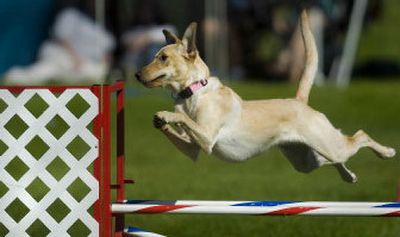Dogs soar, dash at trials

On a grassy field in Spokane Valley, two- and four-legged friends paired Sunday for “jump and weave” fun that could one day become an Olympic sport: dog agility competition.
The American Kennel Club-sanctioned agility trials on Saturday and Sunday, sponsored by the Spokane Dog Training Club, attracted 178 entries from throughout the Pacific Northwest, organizers said.
“AKC agility competition is the fastest-growing of the dog sports,” said trial chairman Tracie Franke, of Nine Mile Falls.
Agility competition didn’t blossom in the United States until the late 1980s after getting its start at the Cruft’s Dog Show in England, where it began as entertainment between conformation judging.
Now, agility competition is hugely popular, with trial competition events somewhere in the Northwest every weekend during the summer.
“It continues to grow at a rate of at least 20 to 30 percent each year, and has the potential to become an Olympic event, like equestrian jumping,” said Franke, who brought her two shelties to the competition that she began organizing a year ago.
The AKC-licensed judge for the event, Dan Butcher of Portland, was flown in to handle the competition between good-natured entrants who put up a large tent sign, “We’ve been butchered.”
They ate pizza and took pictures and movies of the competition, carried out in two arenas, each about 100-by-100 feet.
One course is the “standard agility” layout. Dogs must run over a large A-frame, cross a wooden bridge, balance their way across a teeter-totter, duck through a fabric chute and dash through a tunnel with their owners running alongside, yelling words of encouragement.
The second “jump and weave” course is more difficult. It involves a series of jumps, strategically placed according to AKC rules, a U-shaped tube and a series of closely placed vertical stanchions. Dogs must weave in and out of the stanchions and not knock over any of the cross-bars on the various jumps, or face disqualification – an upward move of the judge’s fist.
For both courses, dogs and their owners are classified in novice, open and excellent classes. Both courses are timed and points awarded are accrued over the season.
On Sunday, there were many kinds of dogs, but the herders seemed to be the most common.
There were golden retrievers, border collies, Australian cattle dogs, Belgian Malinois, a cocker spaniel, dachshunds, miniature pinchers, poodles, bearded collies, corgis, German shepherds and shelties – plenty of shelties.
“To excel, they need to have a good temperament,” said Mary Jane Shervais,president of the Spokane Dog Training Club. “They must have basic obedience training before beginning agility training.”
The agility-trained dogs rarely take their eyes off their owners, and are not distracted by other people or dogs. The owners use voice commands and hand gestures as they coach their dogs through the courses.
Clearly, if Sunday’s scene at University Elementary’s playground was any indicator, the competitive nature of the sport seems to get in the blood of the dogs and their owners.
“I raised my kids,” said Kari Manning, of Spokane. “Now all my energy goes into my dog.”
She brought her 18-month-old yellow Labrador, Emmy, to the weekend competition, the first time the dog has competed. She spends six to eight hours a week training the dog.
“She was bred to do this,” Manning said as her excited, tail-wagging dog took a break in one of dozens of portable kennels and sun tents that lined the field. There also were several trailers and RVs where dogs and their owners spent Saturday night.
“The most important thing is the teamwork, the connection between the dog and the handler,” Manning said. “If there’s a mistake on the course, most often it’s the handler’s fault, not the dog’s.”